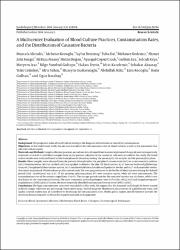| dc.contributor.author | Altındiş, Mustafa | |
| dc.contributor.author | Koroğlu, Mehmet | |
| dc.contributor.author | Demiray, Tayfur | |
| dc.contributor.author | Dal, Tuba | |
| dc.contributor.author | Özdemir, Mehmet | |
| dc.contributor.author | Şengil, Ahmet Zeki | |
| dc.contributor.author | Atasoy, Ali Rıza | |
| dc.contributor.author | Doğan, Metin | |
| dc.contributor.author | Çiçek, Ayşegül Çopur | |
| dc.contributor.author | Ece, Gülfem | |
| dc.contributor.author | Kaya, Selçuk | |
| dc.contributor.author | Iraz, Meryem | |
| dc.contributor.author | Gültepe, Bilge Sümbül | |
| dc.contributor.author | Temiz, Hakan | |
| dc.contributor.author | Demirkan, İdris | |
| dc.contributor.author | Aksaray, Sebahat | |
| dc.contributor.author | Çetinkol, Yeliz | |
| dc.contributor.author | Şahin, İdris | |
| dc.contributor.author | Güdücüoğlu, Hüseyin | |
| dc.contributor.author | Kılıç, Abdullah | |
| dc.contributor.author | Koçoğlu, Esra | |
| dc.contributor.author | Gülhan, Barış | |
| dc.contributor.author | Karabay, Oğuz | |
| dc.date.accessioned | 2020-12-19T19:56:15Z | |
| dc.date.available | 2020-12-19T19:56:15Z | |
| dc.date.issued | 2016 | |
| dc.identifier.citation | Altindis, M., Koroglu, M., Demiray, T., Dal, T., Ozdemir, M., Sengil, A. Z., Atasoy, A. R., Doğan, M., Cicek, A. C., Ece, G., Kaya, S., Iraz, M., Gultepe, B. S., Temiz, H., Kandemir, I., Aksaray, S., Cetinkol, Y., Sahin, I., Guducuoglu, H., Kilic, A., … Karabay, O. (2016). A Multicenter Evaluation of Blood Culture Practices, Contamination Rates, and the Distribution of Causative Bacteria. Jundishapur journal of microbiology, 9(1), e29766. https://doi.org/10.5812/jjm.29766 | en_US |
| dc.identifier.issn | 2008-3645 | |
| dc.identifier.issn | 2008-4161 | |
| dc.identifier.uri | https://doi.org/10.5812/jjm.29766 | |
| dc.identifier.uri | https://hdl.handle.net/11436/2704 | |
| dc.description | Altindis, Mustafa/0000-0003-0411-9669; Karabay, Oguz/0000-0003-0502-432X; KARABAY, OGUZ/0000-0003-1514-1685; Ozdemir, Mehmet/0000-0002-9316-771X; aksaray, sebahat/0000-0002-0552-1337 | en_US |
| dc.description | WOS: 000373926600018 | en_US |
| dc.description | PubMed: 27099693 | en_US |
| dc.description.abstract | Background: the prognostic value of blood culture testing in the diagnosis of bacteremia is limited by contamination. Objectives: in this multicenter study, the aim was to evaluate the contamination rates of blood cultures as well as the parameters that affect the culture results. Materials and Methods: Sample collection practices and culture data obtained from 16 university/research hospitals were retrospectively evaluated. A total of 214,340 blood samples from 43,254 patients admitted to the centers in 2013 were included in this study. the blood culture results were evaluated based on the three phases of laboratory testing: the pre-analytic, the analytic, and the post-analytic phase. Results: Blood samples were obtained from the patients through either the peripheral venous route (64%) or an intravascular catheter (36%). Povidone-iodine (60%) or alcohol (40%) was applied to disinfect the skin. of the 16 centers, 62.5% have no dedicated phlebotomy team, 68.7% employed a blood culture system, 86.7% conducted additional studies with pediatric bottles, and 43.7% with anaerobic bottles. One center maintained a blood culture quality control study. the average growth rate in the bottles of blood cultures during the defined period (1259 -26,400/year) was 32.3%. of the growing microorganisms, 67% were causative agents, while 33% were contaminants. the contamination rates of the centers ranged from 1% to 17%. the average growth time for the causative bacteria was 21.4 hours, while it was 36.3 hours for the contaminant bacteria. the most commonly isolated pathogens were Escherichia coli (22.45%) and coagulase-negative staphylococci (CoNS) (20.11%). Further, the most frequently identified contaminant bacteria were CoNS (44.04%). Conclusions: the high contamination rates were remarkable in this study. We suggest that the hospitals' staff should be better trained in blood sample collection and processing. Sterile glove usage, alcohol usage for disinfection, the presence of a phlebotomy team, and quality control studies may all contribute to decreasing the contamination rates. Health policy makers should therefore provide the necessary financial support to obtain the required materials and equipment. | en_US |
| dc.language.iso | eng | en_US |
| dc.publisher | Ahvaz Jundishapur Univ Med Sci | en_US |
| dc.rights | info:eu-repo/semantics/openAccess | en_US |
| dc.subject | Blood Specimen Collection | en_US |
| dc.subject | Phlebotomy | en_US |
| dc.subject | Blood-Borne Pathogens | en_US |
| dc.subject | Bacteriological Techniques | en_US |
| dc.title | A multicenter evaluation of blood culture practices, contamination rates, and the distribution of causative bacteria | en_US |
| dc.type | article | en_US |
| dc.contributor.department | RTEÜ, Tıp Fakültesi, Temel Tıp Bilimleri Bölümü | en_US |
| dc.contributor.institutionauthor | Çiçek, Ayşegül Çopur | |
| dc.identifier.doi | 10.5812/jjm.29766 | |
| dc.identifier.volume | 9 | en_US |
| dc.identifier.issue | 1 | en_US |
| dc.ri.edit | oa | en_US |
| dc.relation.journal | Jundishapur Journal of Microbiology | en_US |
| dc.relation.publicationcategory | Makale - Uluslararası Hakemli Dergi - Kurum Öğretim Elemanı | en_US |


















